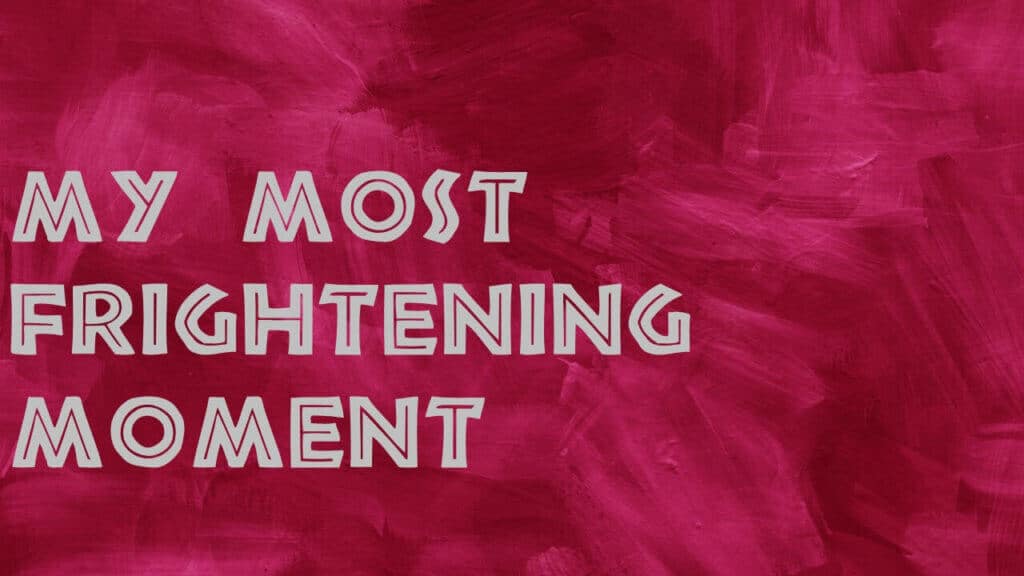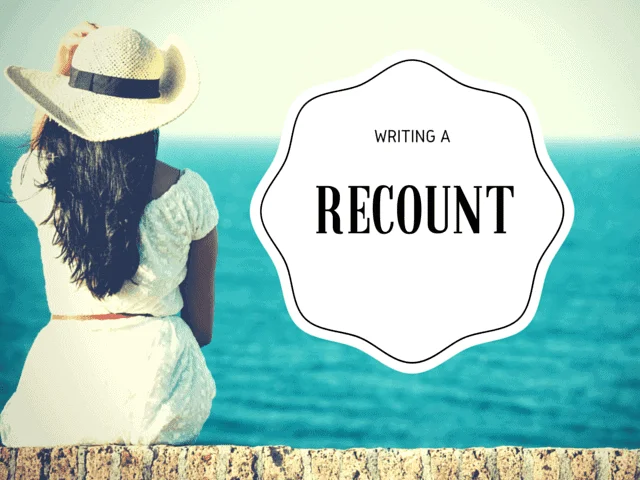
WHAT IS A RECOUNT TEXT?

The recount text type retells an experience or an event that happened in the past. The purpose of a recount is to inform, entertain, and/or evaluate.
A recount can focus on a specific section of an event or retell the entire story. The events in a recount are usually related to the reader in chronological order; That is, in the order they happened.
Recounts are an excellent genre for emergent writers to cut their teeth on.
Written mainly in the past tense, recounts offer younger student-writers the opportunity to tell a story in writing without placing cumbersome demands on their creative abilities to construct a well-structured storyline.
To avoid the necessity for any research, personal recounts are often the best place for beginners to start.
All they’ll need for their plot is a half-decent memory!
A COMPLETE UNIT ON TEACHING RECOUNT WRITING
MASTER RECOUNT WRITING with this complete EDITABLE UNIT that ensures your students learn how to retell events with accuracy and energy. covering PERSONAL, FACTUAL, LITERARY and HISTORICAL RECOUNTS.
Teach your students to write AMAZING RECOUNTS in various styles with this COMPLETE 78 PAGE UNIT. No preparation is required.
WHAT ARE THE FIVE TYPES OF RECOUNT?
There are many different styles of recounting. Let’s take a look at the five main types before studying the recount text structure and features.
PERSONAL RECOUNT: A Personal Recount text retells an activity in which the writer has been personally involved. Personal recounts often build an intimate relationship between the writer and the reader.
Some common types of personal recounts include anecdotes, diary & journal entries, personal letters, etc. While there are some differences, a personal narrative has much in common with a personal recount.

PROCEDURAL RECOUNT: A Procedural Recount records the steps in an investigation or experiment, thereby providing the basis for reported results or findings.
A procedural recount records events such as a science experiment or cooking. Procedural recounts present the events chronologically (in the order in which they happened). The purpose of procedural recounts is to inform the audience. They differ somewhat from a traditional procedural text.
FACTUAL / NEWSPAPER RECOUNT / HISTORICAL RECOUNT: Factual Recounts report the particulars of an incident by reconstructing factual information, e.g. police reconstruction of an accident, historical recount, biographical and autobiographical recounts.
A factual recount is an objective recount of an actual event by someone not personally involved in the situation. Its purpose is either to inform, entertain or both.
LITERARY RECOUNT: A Literary Recount retells a series of events for the purpose of entertainment. A literary recount is like a factual recount in many regards. Both provide details about what happened, including who was involved, when and where the event occurred, and what may have resulted. A literary recount can be about real or fictional events and characters.
IMAGINATIVE RECOUNT: Applies factual knowledge to an imaginary role to interpret and recount events, e.g. A Day in the Life of a German soldier, How I manned the first mission to the moon. An imaginative recount is retelling events, usually in the first person. This style of recount allows for embellishment beyond facts and events- perfect for creative writing.
STRUCTURE AND FEATURES OF A RECOUNT
RECOUNT STRUCTURE
ORIENTATION Explain the who, what, when, and where of the experience in your introduction.
FOCUS Only significant events are included.
CHRONOLOGY Events are described in the sequence in which they occurred.
ORGANIZATION Relevant information is grouped in paragraphs.
INSIGHT Include personal comments, opinions or interpretations of the recounted experience or event.
RECOUNT FEATURES
TENSE First and third person are used most frequently, and recall is always written in the past tense. Present tense can be used for analysis and opinion.
NOUNS Use proper nouns to refer to specific people, places, times and events.
VOICE Both active and passive voice is used in recounts.
CONNECTIVES Use conjunctions and connectives to link events and indicate time sequence.
HOW TO WRITE A RECOUNT
POINTS TO CONSIDER BEFORE WRITING:
Writing a recount text in English is a deeply reflective process. As such, students will want to spend most of their writing time organizing the events, refining the details, and fine-tuning the language. Here are some questions for students to consider before beginning the writing process.
- What are you going to tell your audience? What are you recounting?
- What information will the audience need early in the text?
- What are the important events or parts of the recount you want to describe? In what order will they occur?
- How will you let your readers know the order of events? What language will you use to link the events?
- What other information may it be helpful to include?
- How will you conclude your recount?
Students must recount the who, what, when, and where as the bare minimum. To help them organize their thoughts, encourage the use of graphic organizers and mind maps.
At this point, students should consider some of the questions their audience might ask while reading the recount. For example:
- What occurred?
- Where did it take place?
- When did it occur?
- Who were the main characters/people involved?
- Why did certain things happen?
- How did things happen?
- What were some of the reactions to the events that happened?
- What are the concluding thoughts or ideas?
HOW TO STRUCTURE A RECOUNT IN 5 PARAGRAPHS

In terms of structure, the 5-paragraph/hamburger essay framework is perfect for the beginning writer.
This template suits most nonfiction writing genres and lays out a composition with one introductory paragraph, followed by three body paragraphs and one concluding paragraph. Check out our comprehensive article here to learn more about this effective format.
When used in the context of writing a recount, the 5-paragraph essay will look something like this:
The Orientation: Paragraph 1
In the introductory paragraph, the student will establish the setting and introduce the characters and the topic of the recount.
The Events: Paragraphs 2-4
Using past tense verbs, the student will relate the events in chronological order in the body paragraphs.
The Conclusion: Paragraph 5
In the final paragraph of their recount, the students should typically make some sort of evaluative comment on what they think or how they feel about the events they have just related.
The 5-paragraph essay format is very flexible, as students can easily alter the number of body paragraphs according to their abilities and the complexity of the events they recount.
THE 5 PILLARS OF WRITING A RECOUNT TEXT?
For beginning writers, graphic organizers are extremely helpful tools to assist during the planning process. These can be built around the 5-paragraph essay structure as described above.
Another helpful planning tool to help students plan their recounts is employing The Five Pillars of a Recount.
Essentially, the five pillars comprise five questions students must answer in their recount. These are

- Who? Who are the main characters?
- When? When did the events take place?
- Where? Where did the events happen?
- What? What happened?
- Why? Why do these events matter?
The student will have a basic outline for writing their recount by answering each of these questions.
While the who, the when, and the where are usually addressed in the orientation or introductory paragraph, the what will be taken care of in the body paragraphs, with the why most often providing the focus for the concluding paragraph.
TIPS FOR WRITING A GREAT RECOUNT TEXT
- Keep the title simple to summarise the text’s central element, such as “ A trip to the Zoo.”
- Set the scene for the audience in terms of characters, setting and context. We refer to this as our orientation, and it will provide the reader with all the essential ingredients of the recount in the introduction by addressing the who, what, when and where.
- Keep everything in chronological order in a recount and use a variety of time transitional terms and phrases to keep your audience engaged throughout.
- Use a range of adjectives; try and avoid “And then, and then, and then.”
- Each new section will require a new paragraph. Be sure to check out our Every new section will require a new paragraph. Be sure to check out our own complete guide to writing perfect paragraphs here.
- Use the correct language and terms relevant to your recount. Consider your audience and the language they will connect with.
- If you are writing from a specific point of view, use the relevant language to match the perspective. Most commonly, you will recount in the first person.
- Recounts are always written in the past tense, so be conscious of staying in this tense throughout. Everything has already happened, so ensure your vocabulary reflects this.
- The challenge in writing a good recount is to provide the audience with the story as it happened but to leave out incidental and dull information.
- Ensure you also clearly understand your audience, as this will significantly impact the language you use.

Tools & Resources
Use your students’ resources and tools below to improve their writing skills through proven teaching strategies.
RECOUNT TEXT GRAPHIC ORGANIZER

RECOUNT WRITING PROMPTS AND TOPICS
Often, the topic of the recount will suggest itself in the form of a title. Recounts are great for forging cross-curricular links with other subjects. For example, you may want your students to write a historical recount on a topic they covered in social studies or create a procedural recount on an experiment they completed in science.
Generally, a recount’s focus is summed up in the title. For personal recounts, providing students with a title as a prompt is a great way to get the ball rolling without being too prescriptive, as it will still be up to the student to select the specific events they write about.
Here are a few ideas for titles for personal recounts:
- My Most Magical Moment Ever
- A Moment I Will Never Forget
- A Moment I Will Always Regret
- A Trip with My Best Friend
- My Favorite Memory
- The Biggest Surprise of My Life
- My Proudest Achievement
You’ll find more recount writing prompts for students below.
Recount Writing Example (Student Writing Samples)
Below is an annotated recount text example and student samples. Click on the image to enlarge and explore them in greater detail. Please take a moment to read the different styles of recounting text in detail, as well as the teacher and student guides, which highlight some of the critical elements of a recount to consider before writing.
Please understand these student writing samples are not intended to be perfect examples for each age or grade level but a piece of writing for students and teachers to explore together to critically analyze to improve student writing skills and deepen their understanding of recount writing.
We would recommend reading the example either a year above or below, as well as the grade you are currently working with, to gain a broader appreciation of this text type.
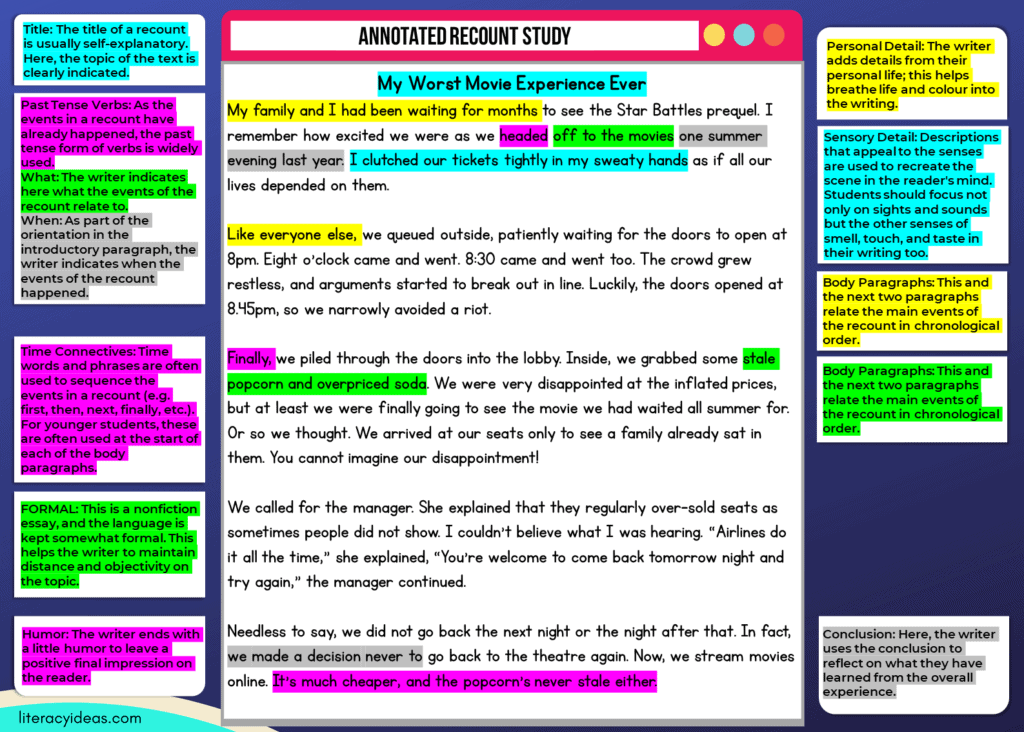

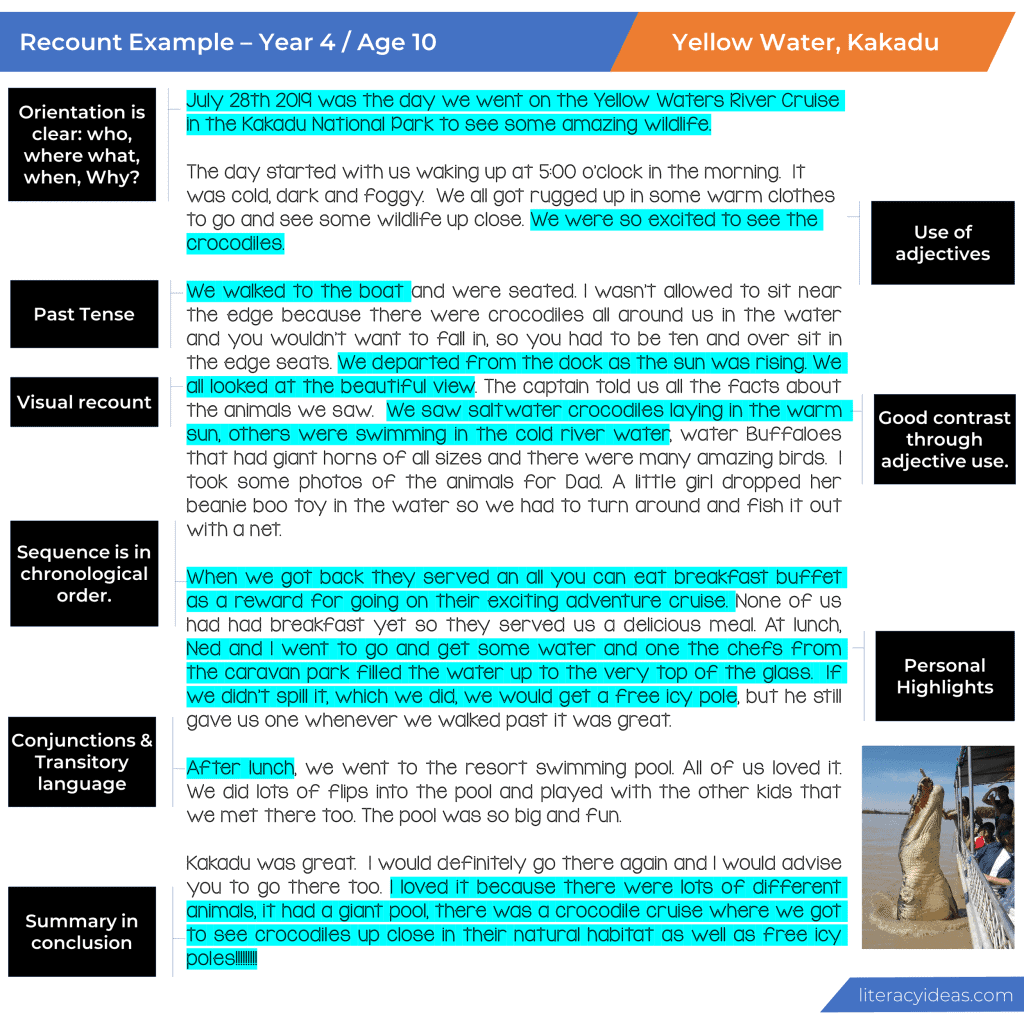
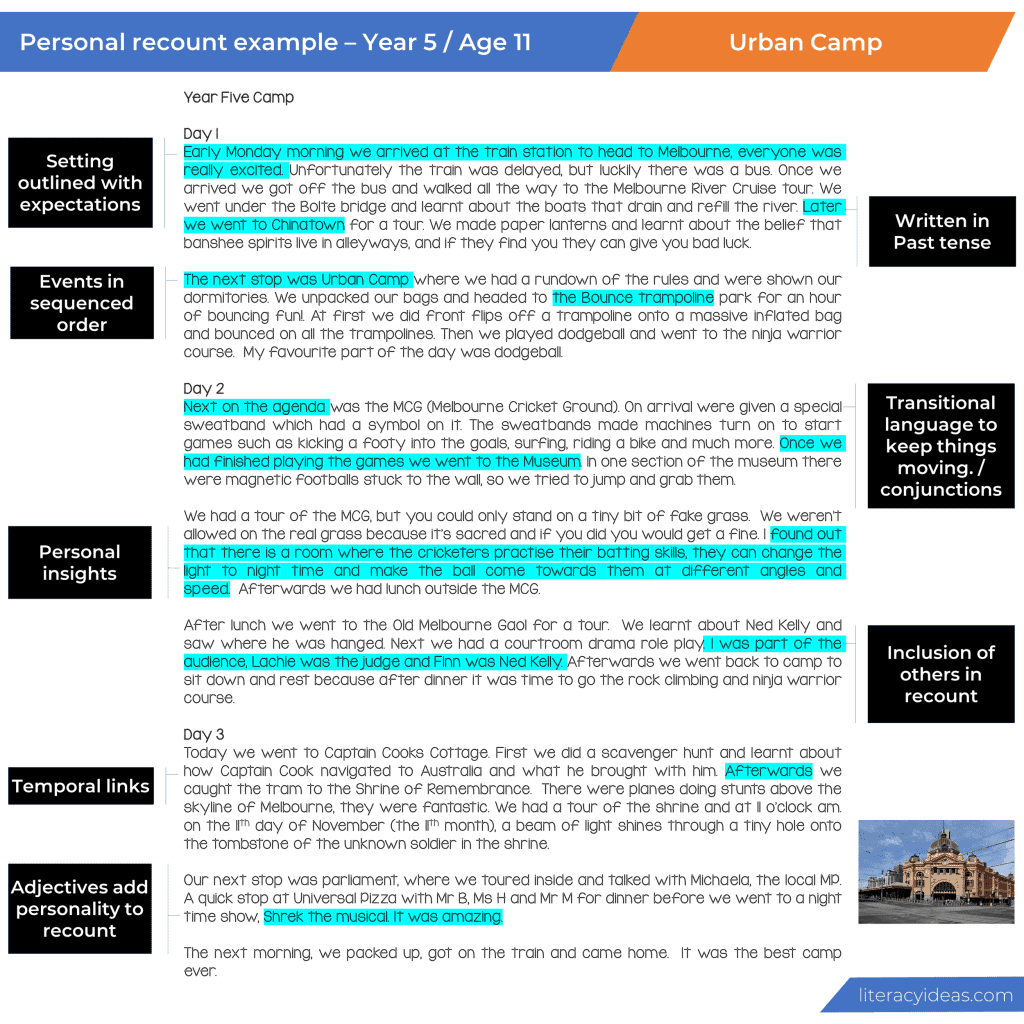



RECOUNT TEACHING RESOURCES
A COMPLETE UNIT ON TEACHING RECOUNT WRITING
MASTER RECOUNT WRITING with this complete EDITABLE UNIT that ensures your students learn how to retell events with accuracy and energy. covering PERSONAL, FACTUAL, LITERARY and HISTORICAL RECOUNTS.
Teach your students to write AMAZING RECOUNTS in various styles with this COMPLETE 78 PAGE UNIT. No preparation is required.
EASY RECOUNT WRITING ACTIVITIES FOR STUDENTS
ACTIVITY ONE: A SHARED VISUAL RECOUNT
Provide an image of a significant event all students could recount as a group. For example, this could be a school camp, the Olympic games, or a photo of a significant event within your community. Get students to work through the Who? When? Where? What? and Why?
Once you have established these, students can start to place things in chronological order and prioritize what will be included in their recount draft.
At this point, get your students to collaborate on a recount of this shared event. You can use these as a starting point for comparison and analysis before students write their individual recounts.
ACTIVITY TWO: BUDDING JOURNALIST RECOUNTS
First, find a suitable video or a newspaper article. Set your students the task of taking notes on the KEY information. Make it clear to your students that they are writing a BRIEF newspaper article to share information with others and that personal opinions are not required for this task. The aim is to provide the audience with enough information to make their own opinions and inferences.
Let your students read or watch the article or video a maximum of twice. Notes should be brief. They are not trying to recreate the entire script or article.
When they have finished, check the chronology of their recounts. How successful were they in recounting the events in order?
ACTIVITY THREE: PAIRED FLOWCHARTS
When your students have created their own individual recounts, get them to share them with a partner. During this time, the reader will develop a flowchart of what happened and, if appropriate, be able to explain an action/reaction process, such as “You ate so much cake at your party that later that night, you got sick.”
By completing this conferencing process, students will hear first-hand if their recount makes sense to others.
RECOUNT WRITING CHECKLIST BUNDLE
⭐⭐⭐⭐⭐ (92 Reviews)
MORE GREAT RECOUNT WRITING ARTICLES

















